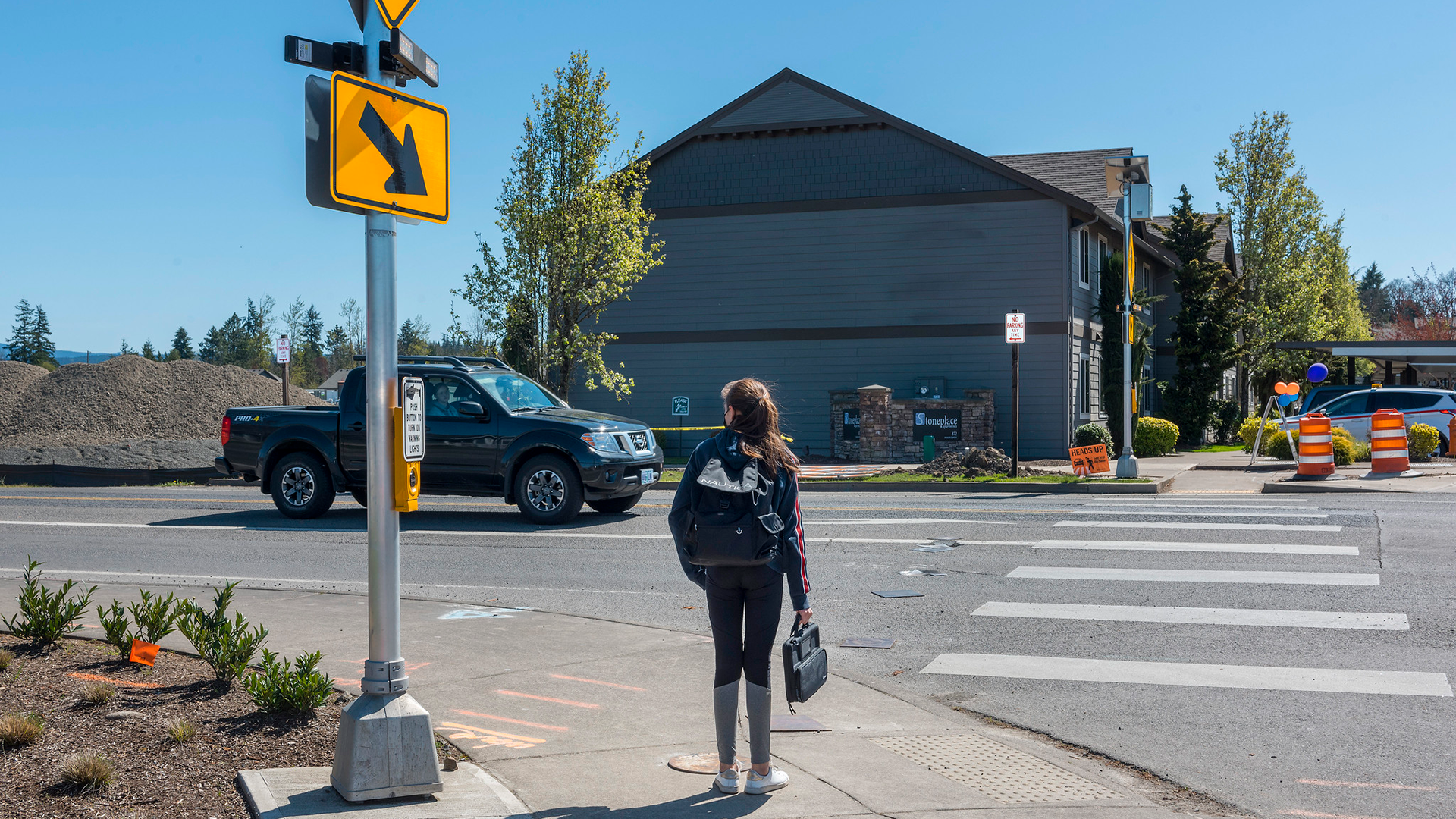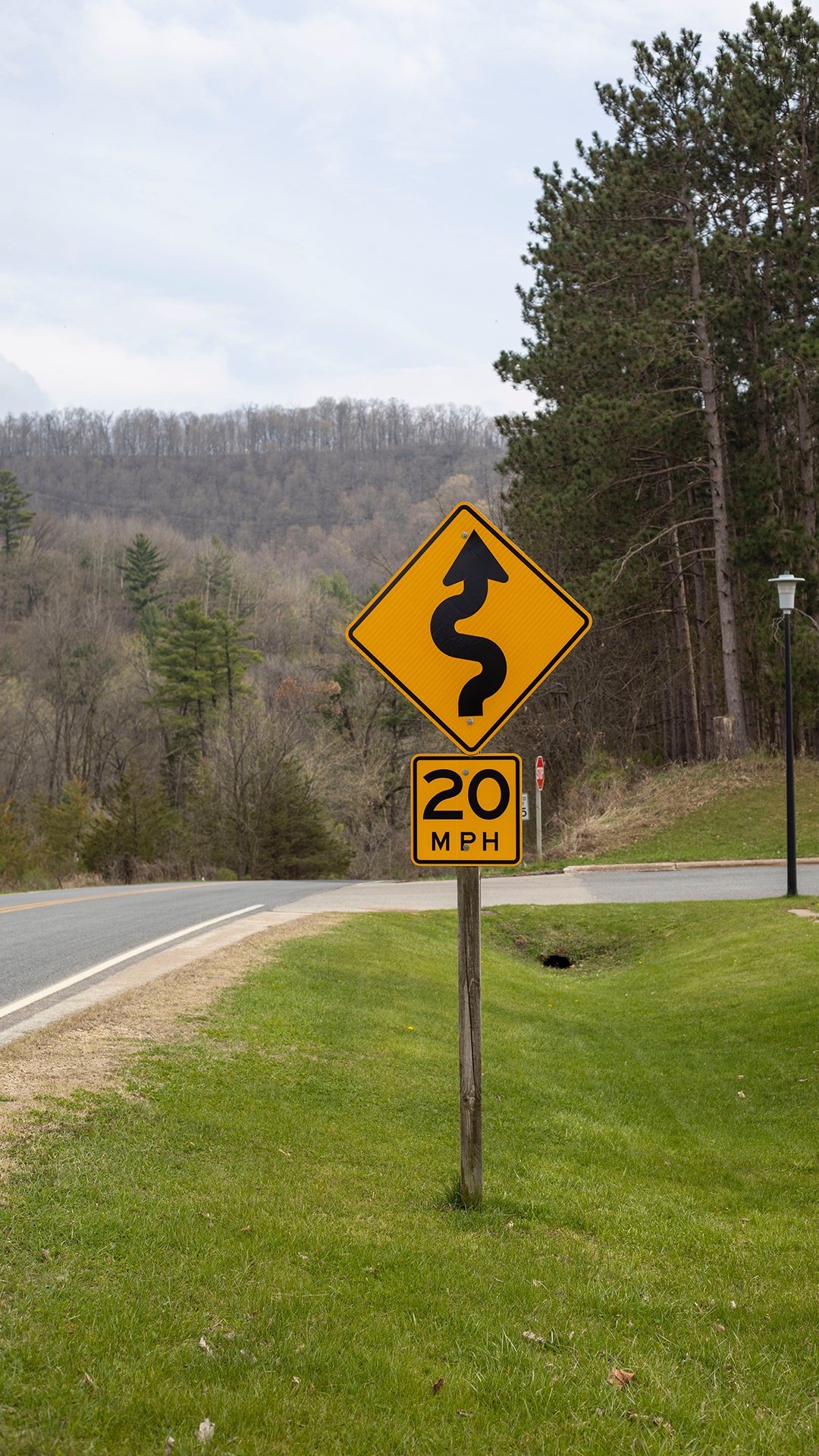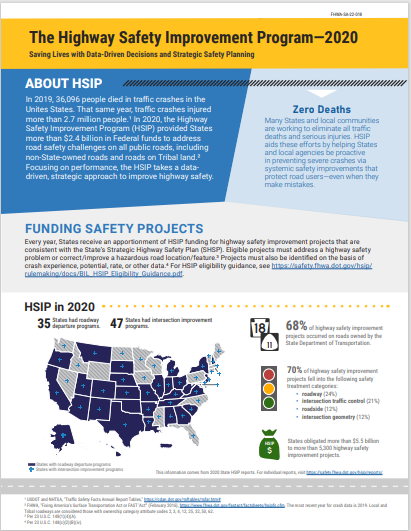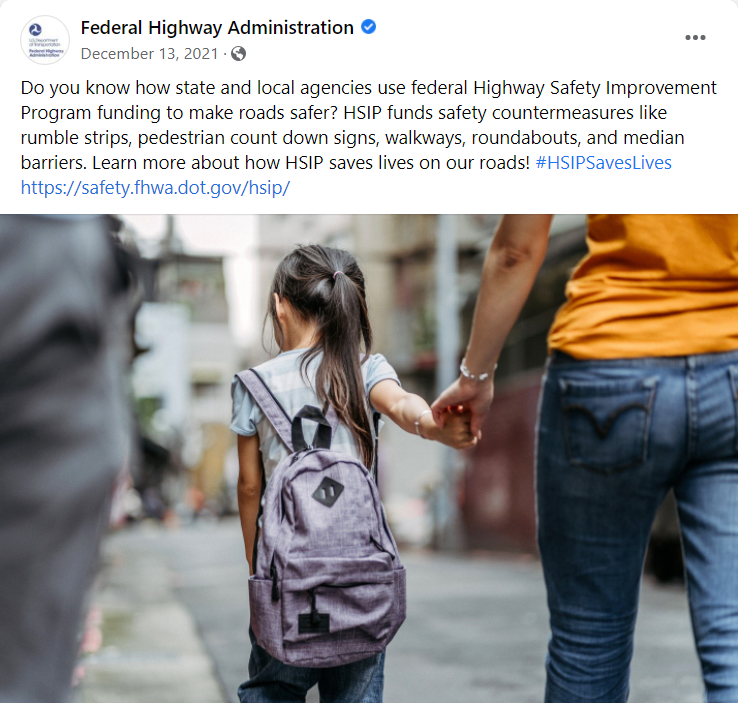June 1, 2022
Road safety is one of the biggest health crises affecting the U.S. today, and data from 2021 shows that traffic crash deaths went up, not down, in the second year of the COVID-19 pandemic.
Communities everywhere are working to eliminate traffic deaths and serious injuries on their roadways. In the face of such staggering statistics, a concerted response and significant resources are needed to move the needle.
In recognition of National Safety Month, we’re highlighting the Highway Safety Improvement Program, which is backing the efforts of States and local agencies to proactively prevent severe crashes via safety infrastructure improvements.

The Highway Safety Improvement Program, known as HSIP, was established by the Federal Highway Administration (FHWA) to encourage the development and implementation of a comprehensive highway safety program in each state.
What is the Highway Safety Improvement Program?
The Highway Safety Improvement Program, known as HSIP, was established by the Federal Highway Administration (FHWA) to encourage the development and implementation of a comprehensive highway safety program in each state. HSIP provides more than $2 billion annually for the implementation of highway safety improvement projects.
Its history dates back to the Highway Safety Act of 1966, which was the first major effort at the Federal level to reduce the number and severity of highway-related crashes. The 1966 Act required each state to develop and maintain a highway safety program following standards established by the Secretary of Transportation.
The Highway Safety Act of 1973 built on this by establishing categorical funding for five program areas: highway-rail crossings, high hazard locations, pavement marking demonstration programs, elimination of roadside obstacles, and the Federal-aid safer roads demonstration. The Surface Transportation Assistance Act of 1978 consolidated these programs into the Railway-Highway Crossings Program and the Hazard Elimination Programs. The passage of SAFETEA-LU in 2005 turned the Hazard Elimination Program into what we now know as HSIP.
Every year, each state receives an apportionment of HSIP funding for safety projects to help them meet the goals documented in their Strategic Highway Safety Plan (SHSP). Projects eligible for funding must address a highway safety problem or correct/improve a hazardous road feature. Each state maintains an HSIP project list, prioritizes projects for funding, and programs and schedules projects into their statewide transportation improvement program (STIP) for implementation.

States used more than $165 million in HSIP funds to projects focused on pedestrian safety in 2020. These projects included crosswalks, pedestrian beacons, pedestrian bridges, and pedestrian signals.
HSIP-Funded Projects in 2020
As FHWA is still awaiting full 2021 reporting, let’s look at 2020 to see what a full year of HSIP funds can accomplish. In 2020, HSIP provided states with more than $2.4 billion in Federal funds to address road safety challenges on all public roads, including non-state-owned roads and roads on Tribal land.
Pedestrian Safety
According to the National Highway Traffic Safety Association, fatal pedestrian crashes increased by 44 percent from 2010 to 2019, with pedestrians making up nearly one third of all traffic fatalities. In response, states used more than $165 million in HSIP funds to projects focused on pedestrian safety in 2020. Some states and territories, like New York, Massachusetts, and Puerto Rico, used 20% or more of their HSIP funds for pedestrian safety improvements. These projects included crosswalks, pedestrian beacons, pedestrian bridges, and pedestrian signals.
Arlington County, Virginia used HSIP funds to install rectangular rapid flashing beacons (RRFBs) at crosswalks, then study their effectiveness. They recorded whether and how often pedestrians actuated the RRFBs, as well as the volumes and characteristics of pedestrians at the crossing, driver yield rates (the rates at which drivers yield to pedestrians), vehicle speed changes while the RRFB was flashing, number of lanes, and posted speed limits. This study revealed that RRFBs reduced speed by 15 percent and increased driver yield by 110 percent-even with increased pedestrian volumes. Arlington County has used this information to screen for future sites where RRFBs would be most effective at improving driver yields.
Safety on Local Roads
Non-state-owned roads are a vital component of a safe transportation system. In 2020, HSIP funded 898 projects on locally-owned roads, with 33 states dedicating at least some of their HSIP funds to safety projects on local roadways. These projects ranged from intersection traffic control and roadway improvements to lighting and speed management.
Through the Off-System Safety (OSS) Program, the state of Georgia allocates $1 million of its HSIP funds for each of its seven districts to apply toward safety projects on its local road network. District coordinators work with the Office of Traffic Operations in the Georgia Department of Transportation (GDOT) and local governments to identify projects through crash frequency and a relative severity index (assigns monetary costs to crashes by site and severity and compares a weighted average of the cost with the average cost of the reference population) and then submit those projects to a selection committee for implementation.
Speed Management

Looking at Safety Systemically
The traditional approach to safety looks for individual locations or corridors with a high number or rate of fatal or serious-injury crashes. A systemic approach to safety asks why crashes happen and where they may happen in the future through examining crash types and looking for infrastructure risk factors. Agencies use the results of a systemic safety analysis to identify and apply countermeasures to mitigate those risks.
In 2020, HSIP funded 1,858 systemic safety projects in 46 states. One third of these projects cost less than $100,000, yet all have the potential to significantly impact system safety.
Missouri Department of Transportation (MoDOT) is a great example. In 2008, MoDOT used HSIP funds to conduct a systemic safety analysis on all State-owned roadways without a painted edge line. They found that more than two-thirds of severe crashes occurred on roadways carrying 400-1,000 in daily traffic volume. Because of this knowledge, they were able to address the issue by adding edge lines to more than 7,500 miles of roads within this range. MoDOT then used a Countermeasure Evaluation Tool to compare 570 miles of rural two-lane State highway before and after the edge striping. The analysis revealed that the new edge lines had decreased total crashes for all crash types by 15.2 percent and fatal and injury crashes by 19.3 percent.
Telling the HSIP Story
Every year, all states are required to submit a report on their use of HSIP funds, including the progress they’re making to implement projects, the effectiveness of the improvements, and the extent to which the improvements have contributed to reducing fatalities and serious injuries on all public roads. All 2020 state reports can be viewed here.
 Traditionally, FHWA would turn these individual reports into a National Summary Report to document the program’s impact. Looking back on 2020, however, FHWA decided it was time to find a new way to disseminate information about HSIP, enhancing the program’s ability to support states and local agencies in pursuing road safety goals. Working with a Kittelson-led team, FHWA compiled a series of five fact sheets (1, 2, 3, 4, 5) that highlight examples and statistics of HSIP funding in a graphical layout. Our safety engineers, in-house communications experts, award-winning graphics team, and FHWA collaborated to distill pertinent points to visually tell the HSIP program story. These fact sheets are written to be easy to access, absorb, and share by practitioners, government officials, lobbyists, and the general public.
Traditionally, FHWA would turn these individual reports into a National Summary Report to document the program’s impact. Looking back on 2020, however, FHWA decided it was time to find a new way to disseminate information about HSIP, enhancing the program’s ability to support states and local agencies in pursuing road safety goals. Working with a Kittelson-led team, FHWA compiled a series of five fact sheets (1, 2, 3, 4, 5) that highlight examples and statistics of HSIP funding in a graphical layout. Our safety engineers, in-house communications experts, award-winning graphics team, and FHWA collaborated to distill pertinent points to visually tell the HSIP program story. These fact sheets are written to be easy to access, absorb, and share by practitioners, government officials, lobbyists, and the general public.
 We’ve also had the chance to support FHWA in the development of an ongoing social media campaign to communicate the impact of HSIP. Raising awareness about HSIP and placing this information in front of people via the channels where they spend time-like social media-has the potential to maximize this impact in the years to come. You can follow along on Facebook, Instagram, and Twitter with the hashtag #HSIPSavesLives. (If your agency has an HSIP success story to share, please use the hashtag, too!)
We’ve also had the chance to support FHWA in the development of an ongoing social media campaign to communicate the impact of HSIP. Raising awareness about HSIP and placing this information in front of people via the channels where they spend time-like social media-has the potential to maximize this impact in the years to come. You can follow along on Facebook, Instagram, and Twitter with the hashtag #HSIPSavesLives. (If your agency has an HSIP success story to share, please use the hashtag, too!)
National Safety Month is a time that keys us into how much work remains to be done to better protect lives on our roadways. At the same time, it’s encouraging to see programs like HSIP that are dedicating significant resources to this work. You can learn more about HSIP here on FHWA’s website.
